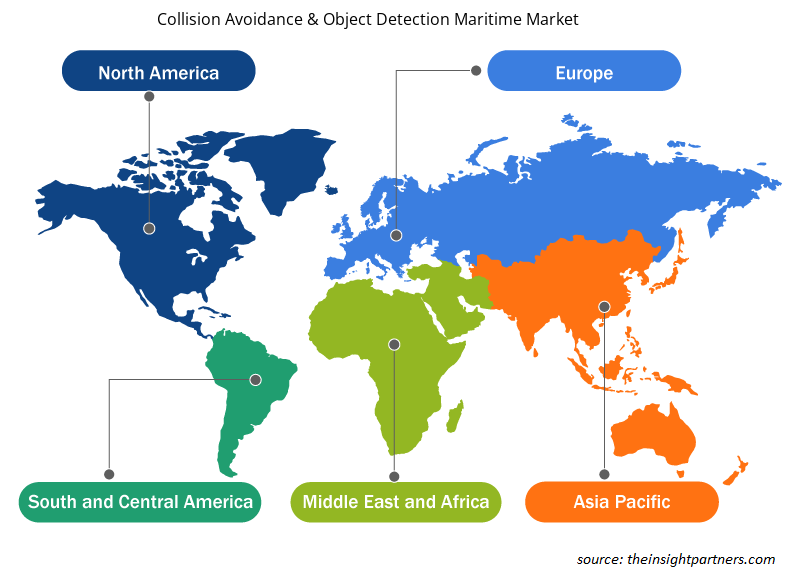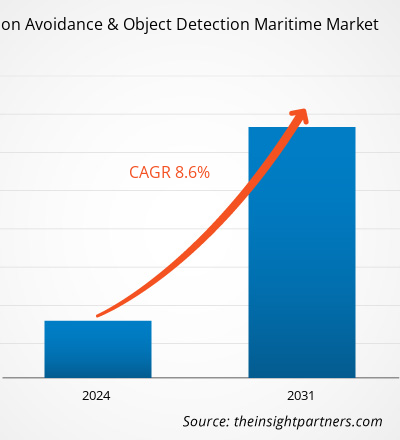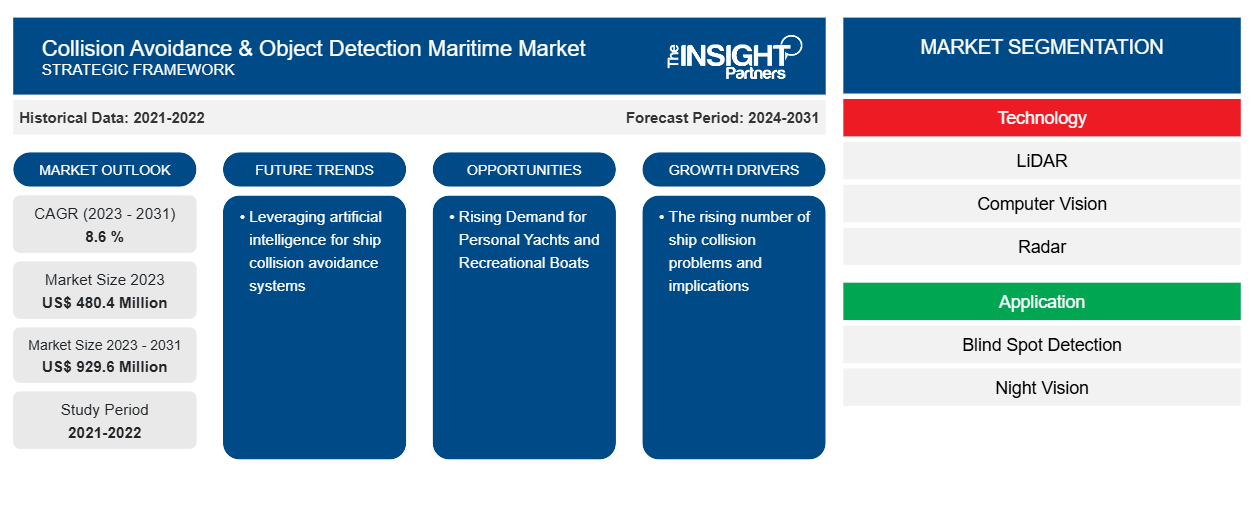من المتوقع أن يصل حجم سوق تجنب الاصطدام واكتشاف الأجسام البحرية إلى 929.6 مليون دولار أمريكي بحلول عام 2031 من 480.4 مليون دولار أمريكي في عام 2023. ومن المتوقع أن يسجل السوق معدل نمو سنوي مركب بنسبة 8.6٪ خلال الفترة 2023-2031. ومن المرجح أن يظل الاستفادة من الذكاء الاصطناعي لأنظمة تجنب الاصطدام بالسفن اتجاهًا رئيسيًا في السوق.
تحليل سوق تجنب الاصطدام واكتشاف الأجسام في القطاع البحري
تعتمد أنظمة تجنب الاصطدام في العمليات البحرية على وسائل ومعايير ملاحية راسخة لتجنب اصطدام السفن وتعمل كأساس للسلامة البحرية. وقد تم استخدام الرادار ونظام عرض المعلومات الإلكتروني ووكالة أبحاث الدفاع المتقدمة ونظام حركة السفن والأضواء والأشكال الملاحية لبعض الوقت. وقد أثبتت أنها موثوقة على مدار سنوات عديدة من الاستخدام الفعلي في مجموعة متنوعة من الظروف البحرية. وتشمل بعض الميزات الأكثر وضوحًا لأنظمة تجنب اصطدام السفن هذه معلومات المدى والاتجاه والوظائف المترابطة وأنظمة الإنذار والتحذير وغيرها.
نظرة عامة على سوق تجنب الاصطدام واكتشاف الأجسام في القطاع البحري
تظل حوادث السفن قضية بالغة الأهمية في الصناعة البحرية، حيث تشكل مخاطر جسيمة على السفن والبيئة وسلامة الأشخاص. وقد أدى النمو الهائل في حركة المرور البحرية العالمية، إلى جانب الازدحام المتزايد في الممرات المائية الرئيسية، إلى زيادة احتمالية وقوع هذه الحوادث. وللتخفيف من هذه المخاطر، ظهرت أنظمة الذكاء الاصطناعي وتجنب الاصطدام بالسفن القائمة على الرؤية الحاسوبية كتقنيات حاسمة لتجنب العوائق. تستخدم هذه الأنظمة الرؤية الحاسوبية على مدار الساعة طوال أيام الأسبوع ودمج أجهزة الاستشعار لتحليل المخاطر في الوقت الفعلي، مما يساهم بشكل كبير في السلامة البحرية.
قم بتخصيص هذا التقرير ليناسب متطلباتك
ستحصل على تخصيص لأي تقرير - مجانًا - بما في ذلك أجزاء من هذا التقرير، أو تحليل على مستوى الدولة، وحزمة بيانات Excel، بالإضافة إلى الاستفادة من العروض والخصومات الرائعة للشركات الناشئة والجامعات
-
احصل على أهم اتجاهات السوق الرئيسية لهذا التقرير.ستتضمن هذه العينة المجانية تحليلاً للبيانات، بدءًا من اتجاهات السوق وحتى التقديرات والتوقعات.
تجنب الاصطدام واكتشاف الأجسام: العوامل المحركة والفرص في سوق النقل البحري
ارتفاع عدد حوادث اصطدام السفن وتداعياتها على السوق
تظل حوادث السفن قضية رئيسية في الصناعة البحرية، ولها آثار بعيدة المدى. وتشير النظرة العامة السنوية للوكالة الأوروبية للسلامة البحرية للحوادث البحرية والوقائع في عام 2023 إلى أن ما يقرب من 4000 حادثة متعلقة بالسلامة تحدث كل عام. وفي حين يشير هذا الرقم إلى انخفاض في الأحداث مقارنة بالسنوات الماضية، فإنه يؤكد أيضًا على استمرار المشكلة. ففي كل عام، تكلف هذه الاصطدامات الصناعة البحرية ما يقدر بنحو 20 مليار دولار أمريكي في الأضرار، وتوقف العمل لفترة طويلة للإصلاحات، والتدهور البيئي، وانقطاع سلسلة التوريد، وحوادث صحة وسلامة الطاقم، وتآكل الثقة بين أصحاب المصلحة من الشركات الذين لديهم مصلحة قوية في البحارة. وتنجم حوادث السفن عن مجموعة متنوعة من الظروف، بما في ذلك الأخطاء البشرية، وفشل الآلات، وسوء الأحوال الجوية. وتدعم مجموعة كبيرة من الأبحاث الخطأ البشري باعتباره السبب الرئيسي للحوادث البحرية. ففي الفترة ما بين 2014 و2022، وجدت تحقيقات السلامة أن 59.1٪ من حوادث الحوادث كانت ناجمة عن نشاط بشري، مع ارتباط 50.1٪ من المتغيرات المساهمة بالسلوك البشري. عندما تم تضمين كل من الأحداث البشرية والعناصر المساهمة في السلوك البشري، كان العنصر البشري مسؤولاً عن 80.7٪ من الخسائر والحوادث البحرية المدروسة خلال هذه الفترة. تم تحديد الثقة المفرطة والتهور في الاستجابة للضغوط التجارية والتعب والافتقار إلى الخبرة والتواصل اللازمين كأسباب أساسية لتجنب الحواجز المناسبة. في تجنب الاصطدامات بين السفن، تعتمد الأنظمة البحرية على المساعدات والمعايير الملاحية المعمول بها لمنع اصطدام السفن وخلق الأساس للسلامة البحرية.
ارتفاع الطلب على اليخوت الشخصية والقوارب الترفيهية
أصبحت اليخوت، التي ترتبط تقليديًا بالرفاهية والترف، أكثر شعبية كأدوات استثمارية. فبالإضافة إلى الرفاهية التي تصورها، توفر اليخوت فرصة مالية فريدة تمتد إلى ما هو أبعد من الأفق. يتجاوز الاستثمار في اليخت التعريف التقليدي للأصول المالية. إنه استثمار في أسلوب حياة ومكانة وإمكانية تحقيق مكاسب مالية. باستخدام التقنية الصحيحة، قد توفر اليخوت مزيجًا من المتعة والربح، مما يجعلها خيارًا جذابًا للأفراد الذين يسعون إلى الإبحار في بحار التمويل ببراعة وتطور. علاوة على ذلك، تعد القوارب الترفيهية بديلاً شائعًا لأي شخص يتطلع إلى قضاء ساعات هادئة على الماء. هذه القوارب هي سفن قادرة على الملاحة الذاتية النشطة وتستخدم بشكل أساسي للترفيه أو الصيد أو الاستخدامات التجارية. ونتيجة لهذا، يتزايد الطلب على اليخوت الشخصية والقوارب الترفيهية؛ وبالتالي، فإن العدد المتزايد من هذه القوارب يخلق طلبًا على نمو سوق تجنب الاصطدام والكشف عن الأجسام البحرية.yachters and recreational boats is increasing; thus, the growing number of these boats is creating demand for the growth of the collision avoidance & object detection maritime market.
تقرير تحليلي لتجزئة سوق تجنب الاصطدام واكتشاف الأجسام في قطاع النقل البحري
إن القطاعات الرئيسية التي ساهمت في استنباط تحليل سوق تجنب الاصطدام واكتشاف الأجسام البحرية هي التكنولوجيا والتطبيق والتطبيق والقطاع.
- استنادًا إلى التكنولوجيا، يتم تقسيم سوق تجنب الاصطدام واكتشاف الأجسام البحرية إلى LiDAR، والرؤية الحاسوبية، والرادار، وغيرها.LiDAR, computer vision, radar, and others.
- على أساس التطبيق، يتم تقسيم سوق تجنب الاصطدام واكتشاف الأجسام البحرية إلى اكتشاف النقطة العمياء، والرؤية الليلية، وغيرها.
- على أساس المستخدم النهائي، يتم تقسيم سوق تجنب الاصطدام واكتشاف الأجسام البحرية إلى مركبات سطحية غير مأهولة، وسفن، ومركبة تحت الماء مستقلة.
تحليل حصة سوق تجنب الاصطدام واكتشاف الأجسام في قطاع النقل البحري حسب المنطقة الجغرافية
ينقسم النطاق الجغرافي لتقرير سوق تجنب الاصطدام والكشف عن الأجسام البحرية بشكل أساسي إلى خمس مناطق: أمريكا الشمالية، وآسيا والمحيط الهادئ، وأوروبا، والشرق الأوسط وأفريقيا، وأمريكا الجنوبية والوسطى. ومن المتوقع أن ترتفع صادرات آسيا والمحيط الهادئ بسرعة، بمساعدة التطور القوي المستمر للتجارة داخل المنطقة في آسيا والمحيط الهادئ، حيث تظل الصين والهند ورابطة دول جنوب شرق آسيا من بين أسرع الأسواق الناشئة نموًا في العالم. تعد سنغافورة البحرية موطنًا لما يقرب من 5000 مؤسسة بحرية و140 من شركات الشحن الدولية الرائدة في العالم، بما في ذلك إدارة السفن والوكالات والتمويل والتأمين والسمسرة والمسح. تدعم الصناعة 160.000 شخص. وبالتالي، فإن وجود مثل هذه الشركات البحرية الدولية ووجهات التصدير يخلق فرصة لنمو سوق تجنب الاصطدام والكشف عن الأجسام البحرية.intra-regional commerce within Asia Pacific, as China, India, and ASEAN remain among the world's fastest-growing emerging markets. Maritime Singapore is home to almost 5,000 maritime establishments and 140 of the world's leading international shipping firms, including ship management, agency, finance, insurance, broking, and surveying. The industry supports 160,000 people. Thus, the presence of such international shipping firms and export destinations creates an opportunity for the growth of the collision avoidance & object detection maritime market.
تجنب الاصطدام واكتشاف الأجسام البحرية
رؤى إقليمية حول تجنب الاصطدام واكتشاف الأجسام في السوق البحرية
لقد قام المحللون في Insight Partners بشرح الاتجاهات والعوامل الإقليمية المؤثرة على سوق تجنب الاصطدام والكشف عن الأجسام في المجال البحري طوال فترة التوقعات بشكل شامل. يناقش هذا القسم أيضًا قطاعات سوق تجنب الاصطدام والكشف عن الأجسام في المجال البحري والجغرافيا في جميع أنحاء أمريكا الشمالية وأوروبا ومنطقة آسيا والمحيط الهادئ والشرق الأوسط وأفريقيا وأمريكا الجنوبية والوسطى.

- احصل على البيانات الإقليمية المحددة لسوق تجنب الاصطدام واكتشاف الأجسام البحرية
تقرير سوق تجنب الاصطدام واكتشاف الأجسام في القطاع البحري
| سمة التقرير | تفاصيل |
|---|---|
| حجم السوق في عام 2023 | 480.4 مليون دولار أمريكي |
| حجم السوق بحلول عام 2031 | 929.6 مليون دولار أمريكي |
| معدل النمو السنوي المركب العالمي (2023 - 2031) | 8.6% |
| البيانات التاريخية | 2021-2022 |
| فترة التنبؤ | 2024-2031 |
| القطاعات المغطاة |
حسب التكنولوجيا
|
| المناطق والدول المغطاة |
أمريكا الشمالية
|
| قادة السوق وملفات تعريف الشركات الرئيسية |
|
كثافة اللاعبين في سوق تجنب الاصطدام واكتشاف الأجسام في القطاع البحري: فهم تأثيرها على ديناميكيات الأعمال
يشهد سوق تجنب الاصطدام واكتشاف الأجسام البحرية نموًا سريعًا، مدفوعًا بالطلب المتزايد من المستخدم النهائي بسبب عوامل مثل تفضيلات المستهلك المتطورة والتقدم التكنولوجي والوعي المتزايد بفوائد المنتج. ومع ارتفاع الطلب، تعمل الشركات على توسيع عروضها والابتكار لتلبية احتياجات المستهلكين والاستفادة من الاتجاهات الناشئة، مما يؤدي إلى زيادة نمو السوق.
تشير كثافة اللاعبين في السوق إلى توزيع الشركات أو المؤسسات العاملة في سوق أو صناعة معينة. وهي تشير إلى عدد المنافسين (اللاعبين في السوق) الموجودين في مساحة سوق معينة نسبة إلى حجمها أو قيمتها السوقية الإجمالية.
الشركات الرئيسية العاملة في سوق تجنب الاصطدام واكتشاف الأجسام البحرية هي:
- شركة بينيواكي (بكين) المحدودة
- منتجات أورلاكو بي في
- شركة رايثيون أنشوتز المحدودة
- جارمين المحدودة
- شركة سي ماشينز روبوتيكس
- روبوبك ساس
إخلاء المسؤولية : الشركات المذكورة أعلاه ليست مرتبة بأي ترتيب معين.

- احصل على نظرة عامة على أهم اللاعبين الرئيسيين في سوق تجنب الاصطدام واكتشاف الأجسام البحرية
تجنب الاصطدام واكتشاف الأجسام أخبار السوق البحرية والتطورات الأخيرة
يتم تقييم سوق تجنب الاصطدامات واكتشاف الأجسام في المجال البحري من خلال جمع البيانات النوعية والكمية بعد البحث الأولي والثانوي، والذي يتضمن منشورات الشركات المهمة وبيانات الجمعيات وقواعد البيانات. فيما يلي بعض التطورات في سوق تجنب الاصطدامات واكتشاف الأجسام في المجال البحري:
- تعاونت شركة Garmin International, Inc.، وهي قسم من شركة Garmin Ltd.، مع شركة Sea Tow Services, International, Inc.، والتي ستوفر لمشغلي الامتياز والأعضاء عروضًا حصرية وتدريبًا على المنتجات لتحسين سلامة القوارب. ستوفر هذه التحالفات الاستراتيجية مع مقدمي المساعدة البحرية الدوليين للأعضاء تدريبًا لتعزيز السلامة من Garmin.
(المصدر: شركة جارمين المحدودة، يونيو 2022)
- أعلنت شركة Velodyne Lidar, Inc. أن شركة Seabed BV متخصصة في المعدات عالية الجودة للتجريف والمسح البحري وقد اختارت أجهزة استشعار Puck لنظام رسم الخرائط المحمول الخاص بها. نظام Seabed هو حل محمول جاهز للاستخدام للمسح الهيدروغرافي والذي يمكن أن يساعد في التخطيط المستدام وحماية البيئات التاريخية والبحرية الحساسة.
(المصدر: Velodyne Lidar, Inc.، يونيو 2021)
تغطية تقرير سوق تجنب الاصطدام واكتشاف الأجسام في قطاع النقل البحري والمنتجات النهائية
يقدم تقرير "حجم سوق تجنب الاصطدام واكتشاف الأجسام البحرية والتوقعات (2021-2031)" تحليلاً مفصلاً للسوق يغطي المجالات التالية:
- حجم سوق تجنب الاصطدام واكتشاف الأجسام البحرية والتنبؤ به على المستويات العالمية والإقليمية والوطنية لجميع قطاعات السوق الرئيسية التي يغطيها النطاق
- اتجاهات سوق تجنب الاصطدام واكتشاف الأجسام البحرية، بالإضافة إلى ديناميكيات السوق مثل السائقين، والقيود، والفرص الرئيسية
- تحليل مفصل لقوى PEST/Porter الخمس وSWOT
- تحليل سوق تجنب الاصطدام واكتشاف الأجسام البحرية يغطي اتجاهات السوق الرئيسية والإطار العالمي والإقليمي والجهات الفاعلة الرئيسية واللوائح والتطورات الأخيرة في السوق
- تحليل المشهد الصناعي والمنافسة الذي يغطي تركيز السوق، وتحليل خريطة الحرارة، واللاعبين البارزين، والتطورات الأخيرة في سوق تجنب الاصطدام والكشف عن الأجسام البحرية
- ملفات تعريف الشركة التفصيلية
- التحليل التاريخي (سنتان)، سنة الأساس، التوقعات (7 سنوات) مع معدل النمو السنوي المركب
- تحليل PEST و SWOT
- حجم السوق والقيمة / الحجم - عالمي، إقليمي، بلد
- الصناعة والمنافسة
- مجموعة بيانات إكسل
التقارير الحديثة
شهادات العملاء
سبب الشراء
- اتخاذ قرارات مدروسة
- فهم ديناميكيات السوق
- تحليل المنافسة
- رؤى العملاء
- توقعات السوق
- تخفيف المخاطر
- التخطيط الاستراتيجي
- مبررات الاستثمار
- تحديد الأسواق الناشئة
- تحسين استراتيجيات التسويق
- تعزيز الكفاءة التشغيلية
- مواكبة التوجهات التنظيمية























 احصل على عينة مجانية ل - تجنب الاصطدام واكتشاف الأجسام في سوق النقل البحري
احصل على عينة مجانية ل - تجنب الاصطدام واكتشاف الأجسام في سوق النقل البحري